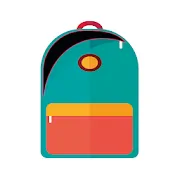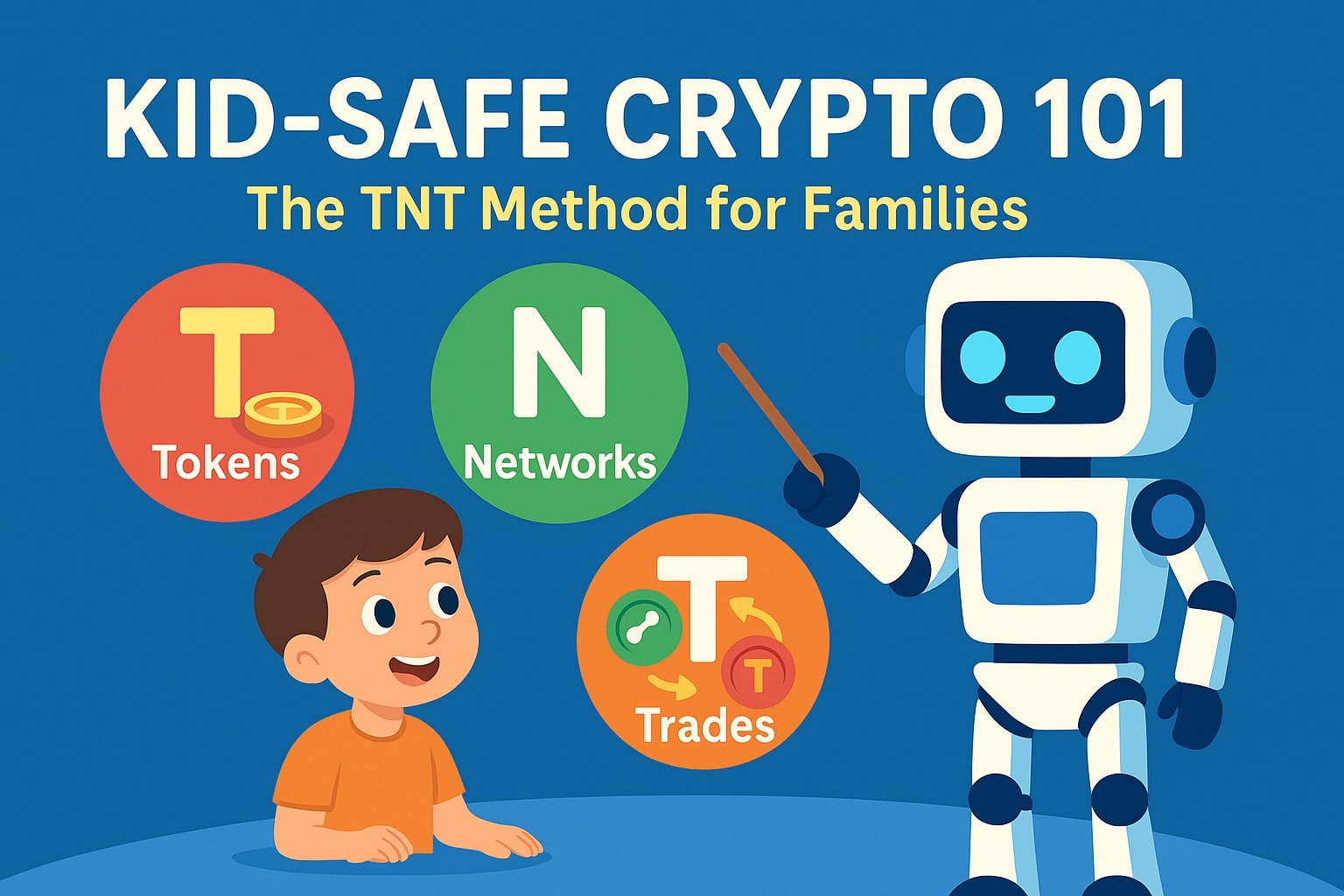Kids bump into “crypto” everywhere gaming chats, shorts, and playground bragging rights. What they don’t get is calm, age-appropriate guidance that values safety over hype. This article reframes the TNT method Tokens, Networks, Trades as a family-first pathway to digital literacy. No speculation, no promises; just clear concepts, hands-on activities, and guardrails that parents can trust.
Educational only, not financial advice. Most exchanges are 18+ and require identity checks. For minors, focus on simulations with active adult supervision.
Why does the TNT method make crypto easier (and safer) to learn at home?
Because it maps an abstract world onto things kids already understand. Tokens are items, Networks are rails, and Trades are swaps. This simple triad keeps discussions concrete, lets parents set boundaries, and encourages reflection instead of impulsive clicking.
What exactly is TNT in plain language?
-
Tokens Digital items with rules. Some grant access (like club passes), others represent collectibles or points.
-
Networks The systems that move and record those items (blockchains work like shared notebooks everyone checks).
-
Trades The ways people swap items or value (marketplaces where price changes as demand rises or falls).
Together they answer three questions kids can hold: What is it? Where does it live? How do people exchange it?
How do you explain blockchain without math?
Tell the “library ledger” story. Imagine a big logbook at the library counter.
-
Students write down a checkout.
-
A small review team verifies each entry.
-
When a page is approved, it’s stamped and photocopied.
-
All copies must match, so changing the past is hard.
That’s the idea: trust through verification, not a single boss.
Are kids allowed to hold real crypto and should they?
Rules differ by country and platform, but most legitimate services are 18+ with KYC. For children, the goal is literacy, not trading. Use paper portfolios, pretend budgets, and classroom-style games. If a family later experiments with real transactions, keep amounts tiny, set a time cap, and review every step together.
What is a wallet, and how can you model safety with zero risk?
A wallet controls keys, not coins.
Activity: Create a fake seed phrase on paper, seal it in an envelope, and run scenarios lost, photographed, or “support staff” asking for it. Kids remember the rule forever: seed phrases are secret.
Coins vs. tokens vs. NFTs how do you tell them apart?
-
Coins are native to a network (issued by the “arcade” itself).
-
Tokens are created on a network by apps or communities (house-rules still apply).
-
NFTs are tokens with unique IDs (like numbered trading cards).
Teach the big lesson early: unique ≠ valuable. Value depends on usefulness, community, and trust.
How do you teach volatility without fear or hype?
Try the “wavy-line chart.” Draw a zig-zag price and ask, “What keeps us calm?”
-
Longer timeframes beat minute-to-minute swings.
-
Never risk money needed for food, rent, or school.
-
Decide rules before any action (if ever).
Curiosity is welcome; impulsivity isn’t.
What’s the quickest way to recognize scams?
Use S.A.F.E.
-
S Source: Only official sites and verified help desks.
-
A Ask: If anyone wants your seed phrase, it’s a scam.
-
F FOMO: “Guaranteed 30x,” timers, or secret invites = red flags.
-
E Extras: Unwanted downloads, surprise wallet pop-ups, or pushy DMs? Stop and ask a parent.
Practice with role-play: the child rehearses saying, “No, I’ll check with my parent.”
What house rules keep learning healthy?
-
Sessions of 20–30 minutes, two or three times per week.
-
A glossary notebook: three new words per session.
-
Simulation first points and paper, not money.
-
Screenshots/notes for every step.
-
Pause rule for anything urgent or secretive.
Can the TNT method connect to school subjects?
-
Math: percentage change, averages, fee comparisons.
-
Civics: how communities vote on upgrades (governance).
-
Art: design a collectible set and write an ethics statement.
-
Computer science: hashing demo same input, same output.
-
Writing: 300-word pro/con on public vs. private networks.
A 7-day starter plan any family can run
-
Day 1 Glossary: Define token, wallet, fee.
-
Day 2 Ledger Game: Approve a “block” of household chores.
-
Day 3 Key Safety: Paper wallet drill; memorize the rule.
-
Day 4 Sorting: Label coins/tokens/NFTs with reasons.
-
Day 5 Fees & Time: Compare fast vs. slow confirmations.
-
Day 6 Scam School: Practice S.A.F.E. responses.
-
Day 7 Teach Back: Child explains TNT to someone else.
Outcome: confident vocabulary and safety habits no accounts required.
How can non-experts evaluate projects sensibly?
Run the 3U Test:
-
Usefulness Can you explain the problem it solves in 1–2 sentences?
-
Users Is there visible, helpful community activity?
-
Understanding If you can’t summarize how it works, skip it.
Green lights: open docs, warnings about risk, active moderation. Red lights: anonymous promoters, copy-paste sites, “risk-free yield.”
Core vocabulary kids should know first
Blockchain, consensus, wallet, key/seed phrase, gas/fee, exchange, stablecoin, airdrop, phishing.
Turn these terms into flashcards or a matching game for quick repetition.
What if your child watches crypto influencers?
Make it media literacy: Who are they? What incentives do they have? Do they disclose risks? Compare claims with official documentation and score the video using the 3U Test.
Mini-lesson tonight: Fees vs. Finality
-
Explain: Fees pay helpers who secure the ledger; finality means the record is locked.
-
Do: Roll a die as a pretend fee. Low numbers wait longer; high numbers confirm faster.
-
Reflect: Why not always pay the max (wasteful)? Why not always pay the minimum (delays)? Trade-offs are part of the lesson.
A quick parent checklist for every session
-
We kept the time cap.
-
The child restated the seed phrase rule.
-
We logged three new terms or steps.
-
We verified sources together.
-
We practiced a risk scenario (phishing/fake support).
Consistency beats intensity ten short sessions beat one marathon.
Building a simple curriculum with TNT
Foundation (TNT 101): tokens vs. coins, wallet basics, S.A.F.E. scam spotting.
Intermediate: fees, block times, confirmations, governance voting.
Advanced-lite: public vs. private chains, privacy choices, environmental trade-offs.
Each lesson: Hook → Core idea → Hands-on (5–10 min) → Reflect → Share.
Frequently Asked Questions
Is Crypto 101 The TNT Method about making money?
No this is digital literacy and safety.
Do we need special apps?
Not at first. Paper exercises and parent-approved websites are enough.
What ages is this for?
Roughly 8–12 for stories/activities; 13–16 for deeper mechanics always supervised.
How much weekly time?
About one hour, split into 2–3 short sessions.
Are there real-world skills here?
Yes: technical writing, spreadsheet modeling, basic scripting, visual design, and ethical decision-making.
Key takeaways
-
TNT distills crypto into Tokens, Networks, Trades a model kids can hold.
-
Safety first: seed secrecy, verified sources, and a pause rule.
-
Learn by doing: simulations, role-plays, teach-backs.
-
No hype: literacy > speculation.
-
Family pact: if anything feels urgent or secret, pause and ask.
Final note: Crypto is a useful lab for math, civics, and online safety. With the TNT method as your compass, families can explore slowly and confidently no trading required. If you’d like, I can convert this into printable worksheets or a 4-week classroom plan for your site.
















